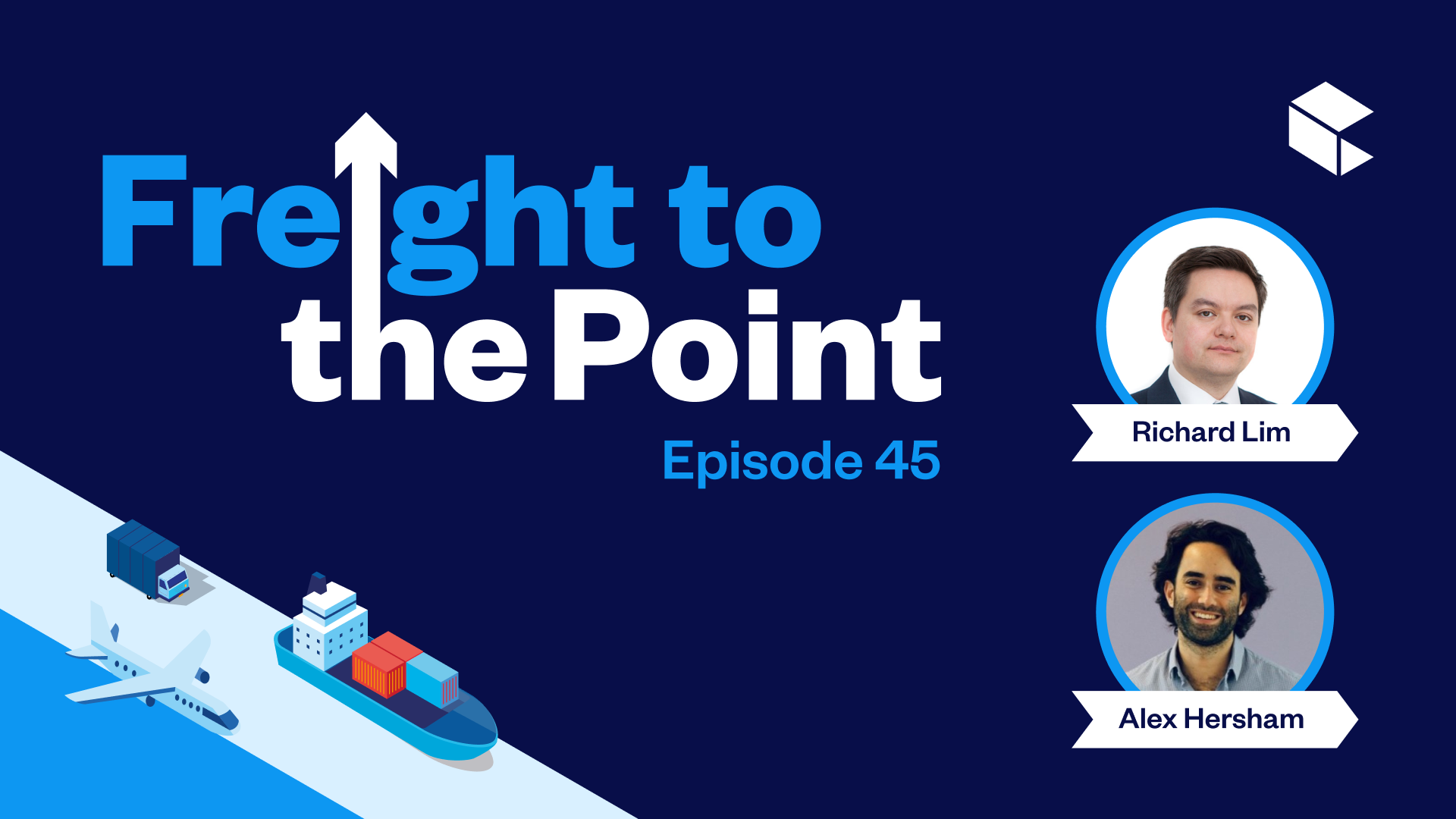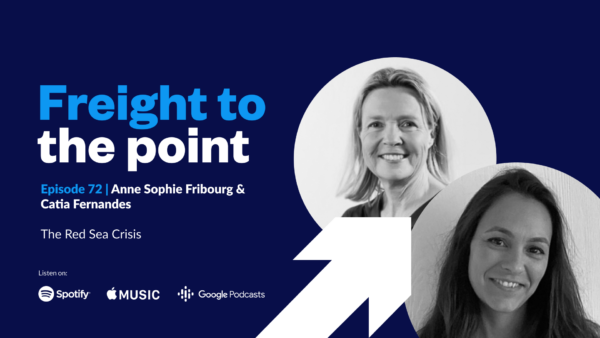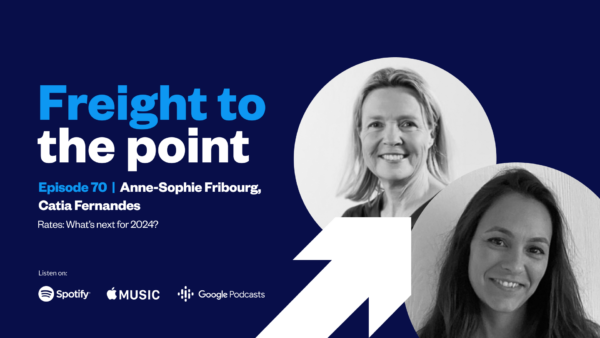Episode 45:
What's next for consumer demand? Part 1
See all episodes

What are we hearing in terms of market inventory levels?
“Nobody knows if we’re going to have restocking. Everyone thinks that we’re getting to a point where inventory levels are starting to balance out, but that doesn’t mean that we’re going to have a restocking environment”
For this episode of Freight to the Point, we’ve featured Part 1 of our Navigate session with Alex Hersham and Richard Lim, Chief Executive of Retail Economics. In this episode, they explore how the economic headwinds have changed since September and how it has affected inventory levels as a result.
They discuss:
- Comparisons to previous financial recessions such as 2001/2002 and 2008/2009
- How inflation has affected retail sales
- How businesses have acted with their inventory levels.
Richard Lim
Richard is the CEO at Retail Economics and previously headed up the ‘Retail Insight and Analytics’ team at the British Retail Consortium. Before that, he worked in mergers and acquisitions for Citi Group. He has a wealth of experience in data analytics, consumer research and macroeconomics, and is skilled in generating actionable insights for clients. Richard is based in London and has a keen interest in Behavioural Game Theory.
Resources
Episode 38: What can we learn from previous recessions to ensure supply chain resilience?
What can economic indicators tell us about what’s next for supply chains?
Hi everyone, and welcome to another episode of Freight to the Point. This week we’re hosting another Navigate session from our most recent event in February.
This episode, we’re featuring part one of our session 2023: What’s Next for Consumer Demand, where Alex Hersham, Zencargo’s CEO and co-founder, is joined by Richard Lim, chief executive at Retail Economics. In this episode, they cover the current economic landscape and its relationship with business inventory levels. We hope you enjoy it.
Alex Hersham:
I’m thrilled to be introducing our first session today. A year ago, supply chains looked pretty different to how they look today. We faced high levels of consumer demand, soaring freight rates, supply chain blockages, and almost a year ago to the day, Russia’s war had just started.
We’re now two months into 2023 and a lot has changed. Energy prices soared, but seem now to be coming down. Freight rates have clearly fallen and consumer demand has dropped off quite a bit since the summer. Retailers are now experiencing a destocking period with high inventory levels, although again, in some instances that seems to be normalizing, but are also thinking about how to manage a potential rebound in consumer demand in late Q2 and certainly into Q3.
So what’s next inventory and demand over the course of this year? That’s all we’ll be talking about first today and who better to join us for this discussion than Richard Lim, who is the CEO at Retail Economics, a leading voice in the retail industry.
So let’s get to business. As mentioned before, Richard Lim is the chief executive officer at Retail Economics, and we’ll be talking about what’s next for consumer demand, how it will affect inventory levels and our predictions for the coming months.
Welcome, Richard. Do you want to maybe give a quick intro on yourself?
Richard Lim:
Brilliant. Yeah. No, thank you, Alex.
So I’m Richard Lim. I’m CEO of Retail Economics. Retail Economics is an independent economics consultancy. We’re focused specifically on retail and consumer industries. Essentially, we’ve put economic analysis, econometric modeling, forecasting at the heart of what we offer our clients in the industry. So delighted to be here for this event.
Alex Hersham:
And welcome, Richard. So we’re going to be talking about the outlook, the inventory outlook, the demand outlook, what people can do in this environment.
But to set the scene a little bit, I think the trading environment is tough, but perhaps not as bad as we thought it might be. The economic headwinds were looking harsher towards the end of September or October compared to now. And if we look at this quote from Andrew Bailey, the Bank of England governor, he says that he thinks inflation will come down rapidly. Now that doesn’t necessarily mean that will be seeing deflationary trends and, of course, trade retailers are seeing still pressures from consumer spending and cost of living. We have the UK dollar exchange rate being volatile and maybe that will be a second wave of impact. But it’s unclear whether the UK will enter a recession and it will certainly be shorter and less severe than previously thought.
What I find interesting is when we think about inventory levels, and we look back to the early 2000s and also to the global financial crisis in 2008 to 2010, where in both environments what we saw was demand falling, inventory levels falling further, are you going through a destocking environment of two to three quarters? But then afterwards some retailers got caught short, and what you saw was three or four quarters after destocking started, you had a restocking environment. I think it’s going to be very interesting to see coming towards the end of Q2 whether those same dynamics played out. Clearly the big difference from both of those events of the past is the inflation level. In 2001, 2002 or 2008, 2009, inflation was relatively muted. We didn’t have double-digit inflation levels, and even if inflation comes back down, we still would’ve gone through this significant wave of inflation.
So what are we hearing in terms of market inventory levels? I would say, firstly, nobody knows if we’re going to have restocking. Everyone thinks that we’re getting to a point where inventory levels are starting to balance out, so that new volumes in or equal demands, but that doesn’t mean that we’re going to have a restocking environment. When I speak to many businesses, and we’ll come onto this later, people are still cautious about Q2, but not really sure about what the future holds beyond that and how they should adjust their strategy.
Richard, I’m not sure what you’ve been seeing and hearing.
Richard Lim:
Yeah. No, thanks for that, Alex. I guess, yeah, taking a step back and looking at the wider macroeconomic environment, I definitely agree with the sentiment that you’ve put out there. I think towards the end of last year, whether it’s the Bank of England or many other kind of forecasting houses, I think the expectation was that the economy was likely to see a deeper and longer recession than we’re currently expecting at the moment.
But the reality is that we’re still heading into quite a challenging condition. We’ve got inflation are still at double-digit levels. We’ve got interest rates that have risen for 10 consecutive occasions, and so there’s kind of a real squeeze on people’s personal finances. And confidence has been hit as well so confidence levels were at record lows at the end of last year, but they have recovered since that period.
So I think there’s still lots of challenges. I think the economic environment has certainly improved over the last three to four months specifically and I do think that there is room for optimism. I think there’s room for optimism because some of the other factors and headwinds have stopped them from a retailer perspective as well. So we’ve seen input costs that have fallen quite rapidly over the last few months. We’ve seen the needs in things like freight costs over the last nine months or so. We expect inflation, as you’ve already called out, to fall rapidly so we’ve gone from a peak of 11% at the end of last year, and we think inflation will be nearer 5% toward the end of this year. So we’re likely to see kind of a rapid fall of inflation and that feed through into confidence. Yeah, so there’s lots of things and there’s lots of room for optimism.
I think heading into the beginning of this year as well, talking down into the kind of inventory picture, if you like, I think heading into the beginning of this year, what we’ve seen with the clients that we work with and also from some of the official data that’s out there is actually conditions are probably better than expected. Retail sales have held up better than expected. Consumer confidence has probably held up better than expected. So actually, although towards the end of last year and heading into this year, inventory levels were higher than many retailers would ideally want, they managed to reduce inventory levels, some of which have been obviously sales-driven.
But generally speaking, I think that the picture is a bit more optimistic than the end of last year. Inventory levels have reduced and consumer demand has probably held up better than many expected, but it’s a mixed picture. I think that’s the key thing is it’s a mixed picture across different sectors.
Alex Hersham:
And that’s what I’m hearing as well. I think businesses are still conservative with the orders that they’re raising, so the purchase orders they’re raising for Q2 and with inventory levels in Q1. Some obviously are holding back inventory and not doing any aggressive discounting because of a strong balance sheet.
But it really gets me curious about what the market might look like in Q2 because if we get to the middle of Q2 and to your point of trading is holding up stronger, or if there’s an expectation that with in the UK the coronation coming up, people are started to get excited about what life after Easter might look like from a demand perspective, I do wonder if we’re going to start to see that inventory overhang quite quickly turn into people thinking about how do they get their hands on more inventory, which leads us to the next question, Richard. Do you have any predictions on what demand might look like over the course of the year?
Thanks for tuning into part one of this episode. We hope you enjoyed it. So what’s next for consumer demand? That’s what we’ll find out in the next episode of Freight to the Point, where Alex and Richard delve into what we’ll expect from the consumer demand in the coming year.
If you like this episode, please don’t forget to subscribe and share with your network. If you have any questions or feedback, please don’t hesitate to contact us on LinkedIn. We’d love to hear from you. But until next time, goodbye.

Episode 72: The Red Sea Crisis
In the latest episode of Freight to the Point, we’ve featured our most rec...

Episode 71: The potential of demand forecasting with artificial intelligence
In the most recent instalment of Freight to the Point, Lucie Phillips, Zen...

Episode 70: Rates: What's next for 2024?
As we prepare for the year ahead, it's crucial to consider the three pillars...

